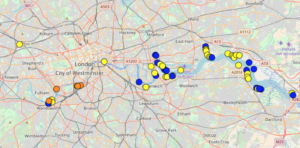For construction logistics planning, and developing Construction Logistics Plans (CLPs) for construction sites and infrastructure developments in London, developers and planning agents should be able to demonstrate that all options including using water and rail for construction freight traffic have been considered.
The Water Freight Toolkit provides a ‘one stop shop’ to help construction companies and developers identify nearby wharves and loading and unloading areas for freight. There are significant benefits of moving freight by water. It is a viable alternative to other freight modes.
Benefits
The river Thames has spare capacity, despite it being the busiest inland waterway in the United Kingdom, carrying 60% of all goods lifted on the UK’s inland waterway network. Department for Transport 2013 statistics show over five million tonnes of freight were transported on the Thames, up 62% on the year before.
- This helps keep over 265,000 lorry movements a year off London’s congested roads.
- Studies have shown that movement of freight by water is better for the environment. For more information please see the CO2 section of this guidance.
- London’s canals also have capacity for additional freight movements.
River Thames
The use of the river Thames for freight is an increasingly stable market and showing signs of a resurgence with the support of organisations such as the Port of London Authority (PLA). The use of water over traditional modes is becoming increasingly attractive for its environmental benefits (e.g. air quality) and avoidance of already-congested transport routes.
The Thames has considerable spare capacity, even though it is already the UK’s busiest inland waterway and is a vital part of the capital and region’s freight infrastructure. The Thames has proved its value in the vital logistics role it played for the London 2012 Olympics with millions of items of equipment/cargo coming into the Port of Tilbury and hence, the Games’ site at Stratford.
Growth potential
Water freight in the London region has excellent growth potential. Around 90% of freight in London is moved by road. Thames freight levels for the previous decade averaged 2.3 Mtpa. The PLA has a target of doubling and maintaining that figure at 4 Mtpa while providing a key opportunity for major infrastructure projects to use the river to move construction spoil, plant/equipment, materials and potentially workers. Large planned infrastructure projects such as Thames Tideway Tunnel, and the Northern Line Battersea extension have seen hundreds of thousands of tonnes of construction materials transported by the River as an alternative to road.
The PLA estimates that every 1,000 tonne barge on the river takes 100 heavy goods vehicle movements off the roads. Based on 2014 data, 5.5Mt of river freight being carried is equivalent to taking 550,000 lorry trips off the region’s roads each year. The Freight Transport Association states that barges are capable of carrying up to 1,000 tonnes, while one HGV can carry 20 tonnes and a van far less.
Air quality
The PLA‘s Draft Air Quality Strategy for the Thames states that waterborne options present an improved air quality scenario compared to road transport. Based on two scenarios tested, waterborne emissions resulted in around four to six times less impact on nitrogen dioxide (NO2) concentrations at the point of measuring air quality, i.e., close to population centres, when compared to the equivalent transits by road.
As vehicle emissions are improving due to tighter regulation, advancing engine technology and innovation (e.g. electric engines), road transport may become relatively more efficient across the entire portfolio of emissions if no similar progress to embrace technological change occurs in the maritime sector.
Read the full report on investigating the barriers to transporting bulk construction materials and waste by river and rail in London here.
Source: CLOCS

